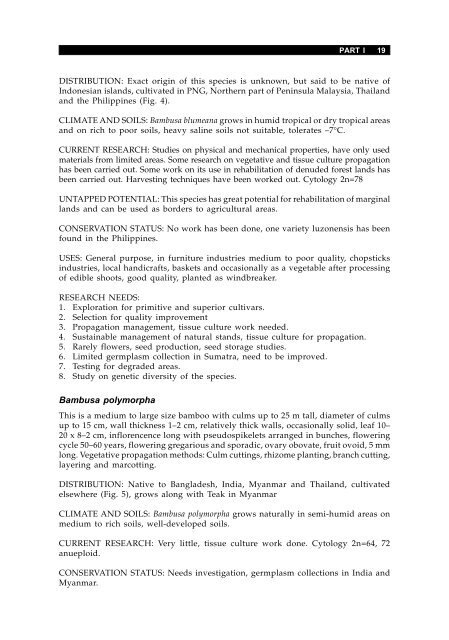Priority species of bamboo and rattan - Bioversity International
Priority species of bamboo and rattan - Bioversity International
Priority species of bamboo and rattan - Bioversity International
You also want an ePaper? Increase the reach of your titles
YUMPU automatically turns print PDFs into web optimized ePapers that Google loves.
DISTRIBUTION: Exact origin <strong>of</strong> this <strong>species</strong> is unknown, but said to be native <strong>of</strong><br />
Indonesian isl<strong>and</strong>s, cultivated in PNG, Northern part <strong>of</strong> Peninsula Malaysia, Thail<strong>and</strong><br />
<strong>and</strong> the Philippines (Fig. 4).<br />
CLIMATE AND SOILS: Bambusa blumeana grows in humid tropical or dry tropical areas<br />
<strong>and</strong> on rich to poor soils, heavy saline soils not suitable, tolerates –7°C.<br />
CURRENT RESEARCH: Studies on physical <strong>and</strong> mechanical properties, have only used<br />
materials from limited areas. Some research on vegetative <strong>and</strong> tissue culture propagation<br />
has been carried out. Some work on its use in rehabilitation <strong>of</strong> denuded forest l<strong>and</strong>s has<br />
been carried out. Harvesting techniques have been worked out. Cytology 2n=78<br />
UNTAPPED POTENTIAL: This <strong>species</strong> has great potential for rehabilitation <strong>of</strong> marginal<br />
l<strong>and</strong>s <strong>and</strong> can be used as borders to agricultural areas.<br />
CONSERVATION STATUS: No work has been done, one variety luzonensis has been<br />
found in the Philippines.<br />
USES: General purpose, in furniture industries medium to poor quality, chopsticks<br />
industries, local h<strong>and</strong>icrafts, baskets <strong>and</strong> occasionally as a vegetable after processing<br />
<strong>of</strong> edible shoots, good quality, planted as windbreaker.<br />
RESEARCH NEEDS:<br />
1. Exploration for primitive <strong>and</strong> superior cultivars.<br />
2. Selection for quality improvement<br />
3. Propagation management, tissue culture work needed.<br />
4. Sustainable management <strong>of</strong> natural st<strong>and</strong>s, tissue culture for propagation.<br />
5. Rarely flowers, seed production, seed storage studies.<br />
6. Limited germplasm collection in Sumatra, need to be improved.<br />
7. Testing for degraded areas.<br />
8. Study on genetic diversity <strong>of</strong> the <strong>species</strong>.<br />
Bambusa polymorpha<br />
PART I 19<br />
This is a medium to large size <strong>bamboo</strong> with culms up to 25 m tall, diameter <strong>of</strong> culms<br />
up to 15 cm, wall thickness 1–2 cm, relatively thick walls, occasionally solid, leaf 10–<br />
20 x 8–2 cm, inflorencence long with pseudospikelets arranged in bunches, flowering<br />
cycle 50–60 years, flowering gregarious <strong>and</strong> sporadic, ovary obovate, fruit ovoid, 5 mm<br />
long. Vegetative propagation methods: Culm cuttings, rhizome planting, branch cutting,<br />
layering <strong>and</strong> marcotting.<br />
DISTRIBUTION: Native to Bangladesh, India, Myanmar <strong>and</strong> Thail<strong>and</strong>, cultivated<br />
elsewhere (Fig. 5), grows along with Teak in Myanmar<br />
CLIMATE AND SOILS: Bambusa polymorpha grows naturally in semi-humid areas on<br />
medium to rich soils, well-developed soils.<br />
CURRENT RESEARCH: Very little, tissue culture work done. Cytology 2n=64, 72<br />
anueploid.<br />
CONSERVATION STATUS: Needs investigation, germplasm collections in India <strong>and</strong><br />
Myanmar.

















